Rand Starliner Looking Good – December 23, 2018
Peter Brill visited Rand Airport on December 8, 2018 posted some photos of ZS-DVJ on Facebook. He was kind enough to share some of them on this website. The first photo shows a smiling Peter sitting in the cockpit of the aircraft. The next photo shows Peter with Starliner restoration project manager Matt Harvey and volunteer Mike Patersen. The QECs have been installed, engines positioned and Peter reports that installation of the engines is the next item on Matt's "To-Do" list. Peter promises an update report and photos when he visits again in March 2019.
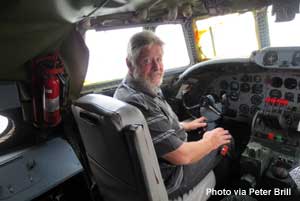 |
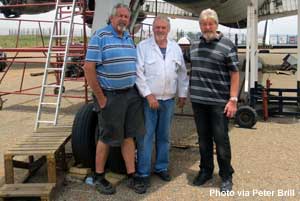 |
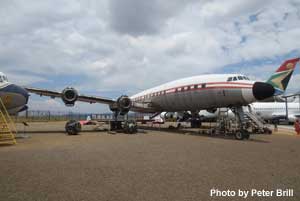 |
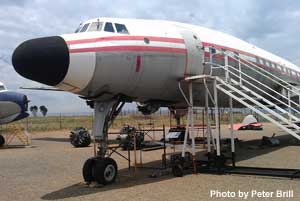 |
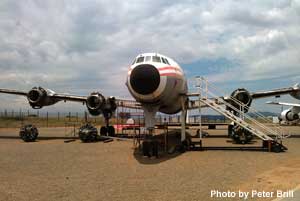 |
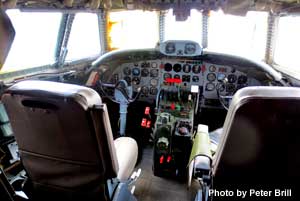 |
Qantas Super Connie Southern Horizon Returns Home – December 17, 2018
A team consisting of QFM volunteers, three Qantas pilots and a retired Qantas mechanic arrived at Ahmed Al Jaber Air Base in Kuwait on November 18, 2018 to salvage parts from former Qantas Airways L1049G VH-EAB Southern Horizon. The aircraft was delivered new to Qantas in 1955 and flew for the airline until 1963, when it was traded-in to Boeing on a purchase of jet equipment. It flew for a number of smaller airlines until being impounded at Kuwait City International Airport in June 1976. Abandoned by its owner, it was moved to Ahmed Al Jaber Air Base, where it was used as a fire trainer. Extensively damaged in the 1991 Gulf War, the wreck has remained untouched at the base ever since.
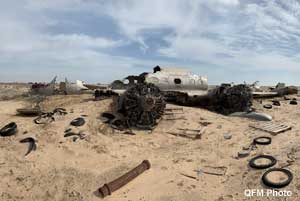 |
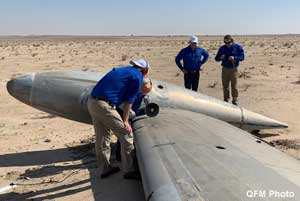 |
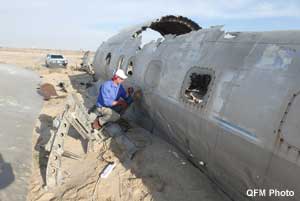 |
 |
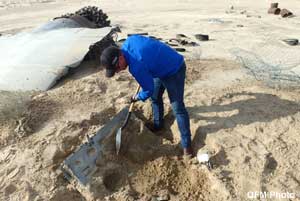 |
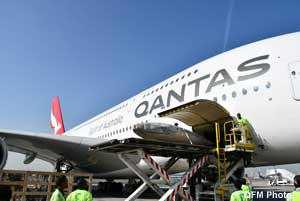 |
SCFA Receives Bad News From FOCA – December 15, 2018
Looks like SCFA Super Constellation HB-RSC is facing additional Federal Office of Civil Aviation (FOCA) mandated inspections. These inspections affect all vintage aircraft registered in Switzerland and was in response to a number of tragic accidents involving vintage aircraft in 2018. Urs Peter Naef, SCFA Directeur RP & Communication, released the following statement on December 12, 2018. Hopefully this is a temporary setback, which can be overcome. I will provide updates on the situation as I receive them.
The 18th general assembly of Super Constellation association members (Connie owners) was held on November 24, 2018 in Basel. 25 of 51 members were in attendance. Both the board’s annual report as well as the annual financial statement were approved by the assembly, providing some relief for the board members. Thanks to two large donations of CHF 1 million each, urgent maintenance work and repairs could be executed continually (for further information please reference the maintenance update on the following page).
Unfortunately however, the board was informed of some bad news two days before the assembly. After the tragic events in vintage aviation in recent months, the FOCA (Federal Office of Civil Aviation) has increased the scrutiny of all vintage aircraft registered in Switzerland. Unfortunately, our aircraft is affected by these decisions, which means that we will have to take an even closer, more in depth look at our aircraft.
Sadly, our concerns became a reality. It remains uncertain when the Connie will fly again. Recent findings revealed that one of the materials used for repairs on the main spar (aluminum 7075 T6) may cause inter-granular corrosion. In order to further investigate this risk, all four wing spars will need to be inspected and possibly replaced. The panels on the leading edge, including the engine nacelles will have to be removed, as well as the landing flaps and their suspension mechanisms on the trailing edge of the wing. Additionally, upper and lower wing tank structural panels will need to be opened. A definitive plan of action will not be devised until a meeting with FOCA representatives will take place. FOCA directives will heavily influence future maintenance works on our “HB-RSC”. If our concerns or discovering corrosion in the main spar become a reality, restoration costs will by far exceed the possibilities of our associations’ budget. While nothing is impossible, it will all boil down to how high the expense would be.
The meeting with FOCA representatives was held on November 30. Unfortunately, it will remain uncertain when our Connie will fly again. Current findings lead to the conclusion that the material used on the main spar (aluminum 7075 T6) can cause internal, inter-granular corrosion. In order to further examine the risks, all four wing spars (T beams) will need to be checked and possibly replaced. The leading edge, including the engine nacelles will need to be removed, the rear part of the wing with the flap suspension mechanisms will need to be disassembled, and upper and lower tank structural panels will need to be opened.
According to expert preliminary statements, these repairs will require the removal of both aircraft wings. In order to repair the corrosion on the ribs, the exterior panels of the engine nacelles will have to be removed. Additionally, all sheet metal firewalls in the engine nacelles need to be taken off in order to check the structure of the spar areas for corrosion. The number 4 engine panels were partially removed over the past two days, and sadly some corrosion was discovered. Unless a different, more cost effective procedure can be found to check the spar, these in depth tasks bear comparison with a complete reconstruction of the entire wing. The board is hopeful that our project may continue, even though the path to getting our Connie back into the air will be long, steep, and costly. For more information, please read our SuperLetter 3|18 which will be mailed out to members before Christmas.
Lufthansa Starliner Glass Cockpit – December 11, 2018
There have been a number of reports, including at least one on Facebook, claiming that one of the reasons that Lufthansa abandoned the restoration of L1649A Starliner N7316C was the FAA’s opposition to the inclusion of a glass cockpit. I received some more recent information regarding this claim. “The project involved several major companies, as well as smaller firms and independent contractors supporting the project. During the project’s glass cockpit upgrade inception the FAA was generally involved through the offices of the Boston ACO. There was no indication that the FAA was opposed to the glass cockpit upgrade. Information about EASA may be different and that may be where the original rumors started. The first photo is the cockpit as it was in July of 2017. The original cockpit integration and installation was designed by CasferAero out of Boise, Idaho. The second photo is the mockup that was produced for the L1649A project.”
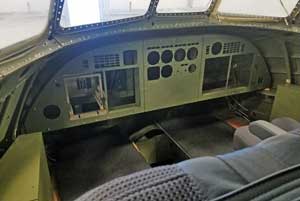 |
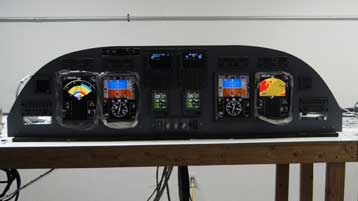 |
"The avionics upgrade was designed in such a way that it would interface with the original L1649A PB-20 autopilot and gyros. The rest of the avionics included a complete set of modernized equipment including displays, radios (ADF,DME, VHF, HF etc.), weather radar, ground prox., inertial system, air data system to name a few."
I’d like to thank my source for their very interesting insight on this extraordinary project, which will hopefully set the record straight...at least for readers of this website.
Great News on São Tomé Super Connies – November 22, 2018 (January 12, 2019 Update)

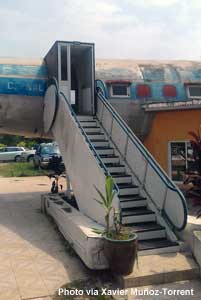 Great news on the São Tomé Super Connies! Volker did some additional research and discovered that they are now part of the Asas D'Avião Restaurante Santola. Volker reports “Both Connies are still in place but partially enclosed by roofs and buildings. This can be seen on the screenshot. Taking pictures of them now is impossible or even more difficult than before." Volker also found a link to photos of the restaurant, which shows the aircraft being well taken care of. Many thanks to Volker for his efforts in providing this update on the two Super Connies.
Great news on the São Tomé Super Connies! Volker did some additional research and discovered that they are now part of the Asas D'Avião Restaurante Santola. Volker reports “Both Connies are still in place but partially enclosed by roofs and buildings. This can be seen on the screenshot. Taking pictures of them now is impossible or even more difficult than before." Volker also found a link to photos of the restaurant, which shows the aircraft being well taken care of. Many thanks to Volker for his efforts in providing this update on the two Super Connies.January 12, 2019 Update -- I received the following message from Xavier Muñoz-Torrent on January 12, 2019 confirming that the two Super Connies were still at São Tomé. "My wife is currently in São Tomé. She sent to me the attached photographs to confirm São-Tomean Super Connies still remain standing. Their condition continues to deteriorate, even though they are part of a restaurant and discotheque. Management of the restaurant changed two years ago and the maintenance is not so good." The Canadian registration CF-NAL is clearly visible in the photo. Thanks Xavier for the report.
Have São Tomé Super Connies Been Scrapped? – November 20, 2018 (November 21, 2018 Update)
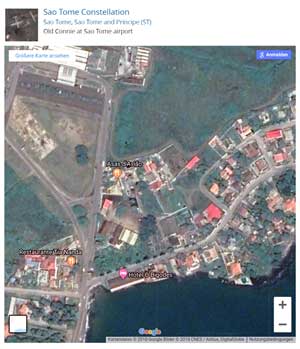 I received an email from Volker Schreiner informing me that Super Connies CF-NAL and CF-NAM were no longer visible at São Tomé International Airport on Google Earth. It’s been quite a while since I’ve had a report on these Biafran Airlift relics and hopefully they haven’t been scrapped. I’d appreciate an email if anyone has some current information about the status of these two aircraft.
I received an email from Volker Schreiner informing me that Super Connies CF-NAL and CF-NAM were no longer visible at São Tomé International Airport on Google Earth. It’s been quite a while since I’ve had a report on these Biafran Airlift relics and hopefully they haven’t been scrapped. I’d appreciate an email if anyone has some current information about the status of these two aircraft.
I received a email from Henk de Waard, which gives me hope that the two aircraft are still extant. "If I look at Google Maps Sattelite I can still see the two Connies at the point where Asas d’Aviao is located facing SSE. This is a 2018 picture. Also on Google Earth dated 24-1-2018 you can still see the two Connies." I will attempt to get an "eyes-on" report from a contact at Sao Tome that previously has reported on these aircraft.
Auburn Starliner Arrives at JFK – November 2, 2018
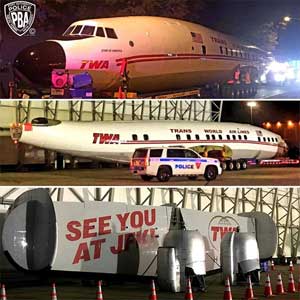 After being held up for over two weeks at the Throgs Neck Bridge because of permit issues, the fuselage of N8083H safely arrived at JFK Airport on Tuesday evening, October 30, 2018. Escorted by Port Authority Police, it joined the engines and empennage which had previously been delivered to a storage facility adjacent to the site of TWA's now demolished Hangar 12. The two wing halves should be arriving shortly and reassembly of the aircraft will begin when the pad at the hotel site has been completed. Great job by Marty Batura and the guys at Worldwide Aircraft Recovery.
After being held up for over two weeks at the Throgs Neck Bridge because of permit issues, the fuselage of N8083H safely arrived at JFK Airport on Tuesday evening, October 30, 2018. Escorted by Port Authority Police, it joined the engines and empennage which had previously been delivered to a storage facility adjacent to the site of TWA's now demolished Hangar 12. The two wing halves should be arriving shortly and reassembly of the aircraft will begin when the pad at the hotel site has been completed. Great job by Marty Batura and the guys at Worldwide Aircraft Recovery.
German Newspaper Frankfurter Allgemeine Zeitung Reports on Lufthansa’s Ill-Fated Super Star/Starliner Restoration Project – October 31, 2018
The following article, published in the German Newspaper Frankfurter Allgemeine Zeitungon on October 5, 2018, offers much of the same insight and information as the previous DER SPIEGEL article. In addition, it reports that “According to industry rumors, to the surprise of the German authorities, the US aviation authority refused to allow the glass cockpit.” This is something that I hadn’t heard before and, if true, would have definitely been a major setback for the project.
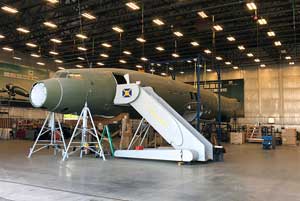 |
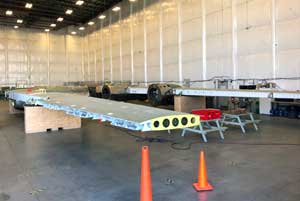 |
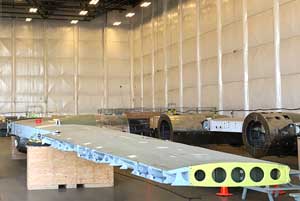 |
by Jürgen Schelling
It’s an aviation legend….the Lockheed Starliner L-1649A was the largest and most luxurious version of the Super Constellation series of airliners produced in the 1950s. Constellations were considered "the most beautiful aircraft in the world" because of their elegant shape and the unusual triple rudder. Thanks to their modern pressurized cabin, they were able to fly above the weather and thus offer up to 100 passengers an unusual level of comfort for the time. Four of these airliners once flew for Lufthansa under the name "Super Star". For the past ten years, Lufthansa has been restoring a Starliner built in 1957. They wanted to offer nostalgic flights on the vintage airliner from 2020 onwards. The project finally seems to have failed. In the purpose-built hangar in Auburn, Maine, the aircraft fuselage is now stored without wings. Because the aircraft will be shipped to Germany, the wings had to be removed. Experts believe that the structure of the aircraft is significantly weakened by this and the aircraft will never fly again.
Originally it was intended to restore the airliner to an airworthy condition. There would include flight testing and approval by the American aviation authority FAA. Afterwards, she was to fly across the North Atlantic to her new homeland Germany on the same route as she did 60 years ago. With a Junkers Ju-52, Lufthansa already operates a vintage aircraft, which has been flying around in Central Europe for many years.
The project began eleven years ago when three long retired L-1649A Starliner aircraft were purchased by Lufthansa to make one aircraft in "better-than-new” condition. Experts estimated the amount invested so far to be more than 100 million euros. Lufthansa Technik, a subsidiary of the group, has been responsible for the reconstruction so far. That this was so costly is because the quality of the restoration would result in the Super Star being like a modern passenger carrying airliner. It included the collision warning and flight planning and navigation systems that are installed on Boeing and Airbus airliners being built today. The veteran airliner would have been able to fly in instrument flight conditions and thus be capable of all weather flight. However, the aircraft’s need for the rare aviation fuel required for its piston engines would have been a logistical nightmare, since all modern jets and turboprops fly with kerosene.
In order to facilitate modern day pilots flying the classic, a glass cockpit with several screens was being installed. However, the approval for such high-tech aerospace equipment in a vintage airliner is expensive and complicated. According to industry rumors, to the surprise of the German authorities, the US aviation authority refused to allow the glass cockpit. According to experts, the costs got so out of hand that the Lufthansa CEO pulled the emergency brake.
In the world there are only two airworthy Super Constellations of the smaller L-1049 series: the "Star of Switzerland" in Switzerland and a similar aircraft in Australia. The Swiss Super Connie is currently undergoing extensive maintenance. After almost two years of repairs, it will take off again in time for the 2019 flying season. German Lufthansa pilots and flight engineers had previously trained in the Swiss aircraft.
German Magazine DER SPIEGEL Reports on Lufthansa’s Ill-Fated Super Star/Starliner Restoration Project - October 29, 2018
Lufthansa’s March 2018 cancellation of the Super Star/Starliner restoration project has caught the attention of the German mainstream media. The following article was published in the German weekly news magazine DER SPIEGEL on October 20, 2018.
Dispute Over Historic Airliner – No Heart for a Super Constellation
by Dinah Deckstein
Lufthansa CEO Carsten Spohr is involved in a dispute with aviation enthusiasts. He wants to stop the restoration of an historic plane because the costs have run out of control and he fears the wrath of shareholders. Spohr likes to think back to the annual stockholders general meeting at the beginning of May in the Jahrhunderthalle in Frankfurt. Visibly flattered, Spohr accepted the homage of his followers, who praised him for the company’s record profit.
But the meeting got a bit exciting shortly before ending. A shareholder asked him if it was true that Lufthansa had spent up to 200 million euros on the restoration of a Lockheed Super Star and if he planned to finish the project.
Spohr was prepared and he answered the question elegantly: At most, 150 million euros had been spent he assured, with one-third being contributed by project sponsors. In the next few weeks or months, he said casually, the semi-finished aircraft would be transferred from the United States to Germany.
For good reason, Spohr consciously avoided the fact that the machine would never fly again, as originally planned. What the Lufthansa boss announced there was a sacrilege but hardly anyone noticed that at that moment.
Ironically, Spohr, the trained pilot, intended on ending an adventure that has been going on for more than ten years centering on a unique aircraft: the legendary Super Star Constellation produced by the US manufacturer Lockheed Aircraft. It was considered a symbol of outstanding engineering and Lufthansa's re-emergence after the war.
The Super Constellation traces its roots back to the ingenious and eccentric multi-millionaire Howard Hughes. With its high-legged fuselage and delicate triple tail empennage, it is considered by many to be the most beautiful airliner ever built. Lufthansa began operations with the Super Constellation in 1955. With four piston engines, the Super Constellation was flown on long distance routes to the USA such as from Hamburg to New York.
With the introduction of jetliners a few years later, the Super Constellation became obsolete and they were gradually retired from airline service. To this day, aviation enthusiasts and retro fans around the world worship the Super Constellation and its last variant, the Super Star, of which only 44 were built.
Lufthansa was home to a particularly large group of Constellation enthusiasts. At the end of 2007, the company purchased three grounded Super Stars plus accessories and engines from the bankruptcy estate of a collector in the US state of Maine for $750,000. This was done with the approval of former technology director August Wilhelm Henningsen and former group chief executive Jürgen Weber. The aim was to rebuild a single airworthy aircraft using components from the three aircraft.
"This project is unique in the world," enthused Weber. At that time, he had no idea the project would be so expensive. His successor as CEO, Wolfgang Mayrhuber, was equally enthusiastic: "Everyone who has a heart for technology, is committed to the Super Connie," he cheered.
The restoration began in a purpose-built hangar at the Auburn-Lewiston Airport in Maine in late 2008 and was estimated to cost a maximum of 20 million euros. The restoration was expected to be completed as early as 2010, with the vintage airliner giving aviation enthusiasts the opportunity to experience luxurious long distance transoceanic flights in a vintage Propliner.
Up to 80 technicians were employed in Auburn at peak times. They performed tons of unpaid overtime in their enthusiasm. Nevertheless, the project did not progress as quickly as had been expected. To comply with modern flight regulations, some parts and systems such as avionics had to be completely redesigned and built by hand. That took time and costs ran out of control.
Suppliers such as Airbus, Boeing, GE and Pratt & Whitney were urged to sponsor the project, which they did. Depending on their contribution, they received a status of being a "Silver", "Gold" or even "Diamond" partner. However, interest was limited because these companies could have been accused of exerting undue influence on a customer. Meanwhile, the planned date for the maiden flight moved further and further into the distance. The final official projection was 2019.
Last year, the situation came to a head. In August 2017, hangar sprinkler system activated resulting the in the hangar filling with up to seven meters of firefighting foam. Later, Lufthansa settled a multi-million dollar unpaid overtime dispute with a group of mechanics in Auburn.
From then on, it was clear that Lufthansa was going to have to pay workers on the project overtime premium pay overtime hours. In the past restoration workers would often work more than 60 hours a week without being paid overtime. In the future, restoration of the aircraft would become even more expensive. That's another reason why the Lufthansa CEO Carsten Spohr stopped the project.
In May 2018, more than 8,500 Constellation enthusiasts signed an online petition imploring Spohr to continue the project but Spohr apparently didn’t want to be accused by shareholders of wasting corporate assets out of a passion for aviation nostalgia.
Most of the remaining employees in Auburn have already been dismissed. The one-piece wing has been split into two halves. Subsequently, the semi-finished aircraft was disassembled into individual parts and will be shipped to Germany. Once there, it will be placed into storage until a three-man Lufthansa special commission decides on its ultimate fate.
Maybe the aircraft will be exhibited at the Frankfurt airport. An example of this already exists at Munich Airport. Since 2001, a Super Connie in original Lufthansa colors has been on display in the visitor park. The veteran aircraft can be seen from afar with his whale-shaped fuselage and the triple tail.
If the Frankfurt Airport plan moves ahead, there might soon be another place of pilgrimage for Connie fans in Germany
After all…
Maine Starliner Roadtrip – October 28, 2018
As reported on this website on September 19, 2018 the reassembly of L1649A Starliner N8083H was completed on September 12, 2018 and turned over to Marty Batura of Worldwide Aircraft Recovery for transport to JFK Airport in New York City. Over the previous 3 1/2 months the aircraft had been resurrected from near-derelict condition by Carlos Gomez and Roger Jarman. Painted in 1950’s era TWA colors, it looked ready to board passengers! Marty and his crew immediately set about disassembling the aircraft and by October 8th the various components of the airplane had been loaded on lo-boy trailers for the 300+ mile trip to JFK Airport. The convoy departed Auburn on October 9th and headed down I95 at 15 mph accompanied by a police escort. Things went well until the next day when the trailer carrying the fuselage experience a flat tire in Bolton, Massachusetts. With the tire replaced, the caravan proceeded south as planned until reaching the Throgs Neck Bridge in Bronx, New York where it was stopped due to a permit issue. While the tail assembly, engines and other components were allowed to proceed the final 20 miles to JFK Airport, the fuselage was not allowed to cross the bridge and, as best I can tell, still awaits permission to cross. The 150 foot wing assembly had been left behind in Maine because it was too large to transport in one piece. A crew from Worldwide returned to Auburn on October 26th to split it in half and it will be on the road south shortly. Here are some photos taken on October 7th and 8th at Auburn.
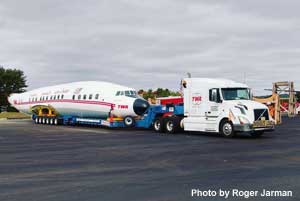 |
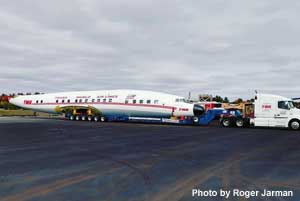 |
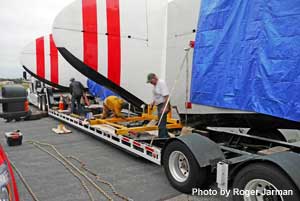 |
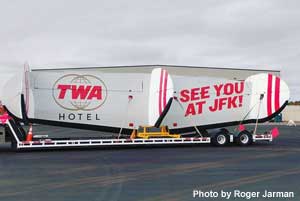 |
 |
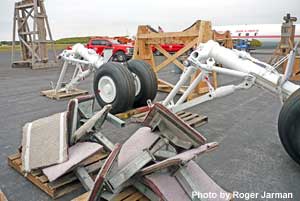 |
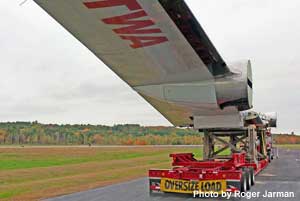 |
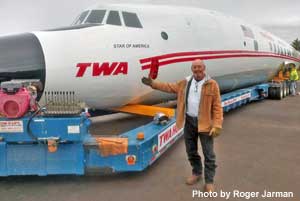 |
 |
MCR TWA Hotel Project Official Press Release
The project and roadtrip has caught the attention of the mainstream media so check out these links for additional articles, photos and videos. I don't know how long these links will remain current so don't waste any time checking them out.
October 9th Sun Journal Report on the Departure From Auburn
October 9th CBSPHILLY Report on the Project
October 10th necn Report on the Flat Tire in Bolton, Massachusetts
October 10th WBZ Report on the Flate Tire in Bolton, Massachusetts
October 10th WCVB Report on the Project
October 13th CNN-Travel Report on the Project
SAA Museum Starliner Update – October 25, 2018
Tobias Ralle reports on the latest status of the restoration of South African Airways Museum Starliner ZS-DVJ at Rand Airport. "I was in Rand last week and attached are two pictures of the Starliner. As reported on your website, she is back on her feet; empennage and engines lie in open storage in the premises of the museum compound, with work to be continued but with no specific deadline. She is parked rather packed with no space to take good pictures." Many thanks to Tobias for his report and photos.
 |
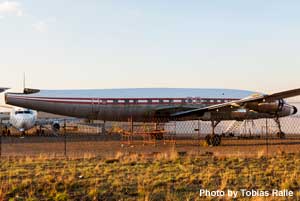 |
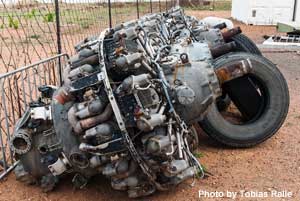 |
Quimper Super Connie Continues To Deteriorate - October 25, 2018
Roger Poland came acrross former Air France Super Connie F-BHBG while visiting Brittany, France in October of this year. The aircraft has been parked in a field near the city of Quimper for over 40 years. With the exception of engines, the aircraft is essentially complete externally but 40+ years exposed to the elements has taken its toll on the aircraft. A few years ago the outboard vertical stabilizers fell off and the right wingtip has been damaged. Many thanks to Roger for his report and photos.
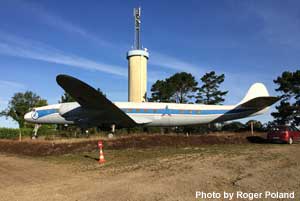 |
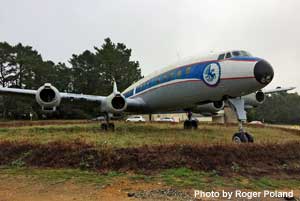 |
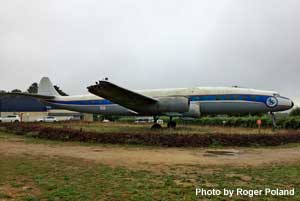 |
Resurrection of Auburn Starliner Complete – September 19, 2018
As reported on this website on June 25, 2018, Roger Jarman of Atlantic Models teamed with Carlos Gomez to resurrect L1649A N8083H. When Carlos and his small team arrived in Auburn, Maine on Memorial Day, the aircraft was essentially a stripped hulk, which had been used as a source of spare parts for Lufthansa’s ill-fated restoration of L1649A N7316C. Three and a half months later, an amazing transformation of the aircraft’s exterior and cockpit had been completed. Painted in vintage 1950’s TWA colors, the aircraft looked like it was ready to board passengers! While Carlos concentrated on reassembling the aircraft in Auburn, replica propellers, new passenger and cockpit windows and other needed parts were fabricated by Atlantic Models in Miami. The aircraft will be used as a cocktail lounge at the hotel currently under construction adjacent to the iconic TWA passenger terminal at JFK. After inspection and acceptance by hotel developer MCR on September 12th, the aircraft was turned over to Marty Batura and his crew from Worldwide Aircraft Recovery. The Worldwide team will disassemble and transport the aircraft to JFK Airport, where it will be reassembled and fitted with a cocktail lounge interior. The aircraft is scheduled to arrive at JFK in October 2018, with reassembly completed the following month. Congrats to Carlos and Roger for an outstanding job resurrecting this iconic aircraft and to MCR for having the vision to make the aircraft part of its hotel project. I’ve included a “before” and “after” photos of the aircraft…what a stunning transformation!
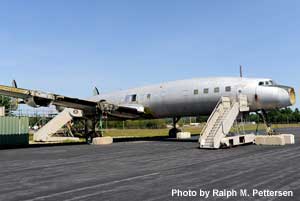 |
 |
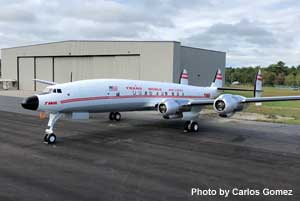 |
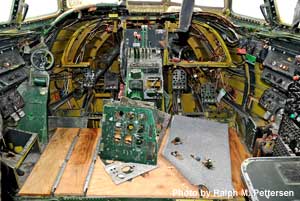 |
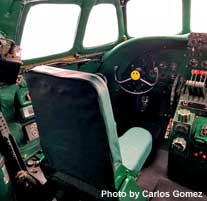 |
 |
SAA Museum Starliner Back on Her Feet – September 18, 2018
The South African Airways Museum successfully completed a major milestone on September 14, 2018 when landing gear were installed on Starliner ZS-DVJ at Rand Airport. A few days later on September 17th the aircraft was towed onto museum grounds at the airport, where the restoration of this magnificent aircraft will continue. Many thanks to John Austin-Williams for providing photos of the event. For more information and photos about this exciting project, check out the museum’s website.
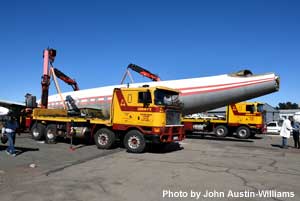 |
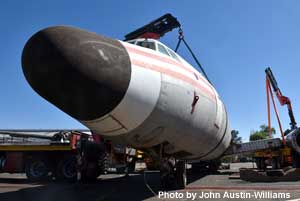 |
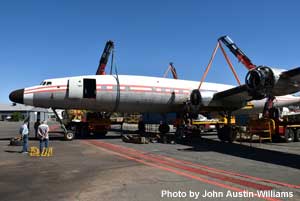 |
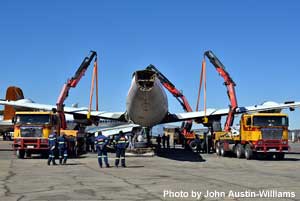 |
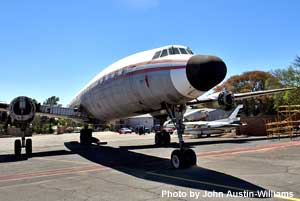 |
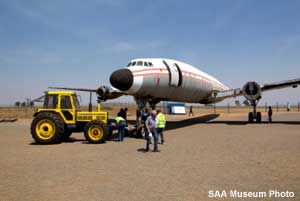 |
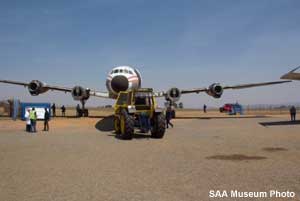 |
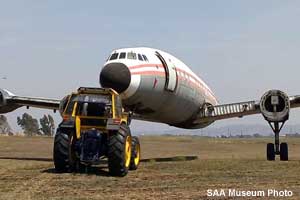 |
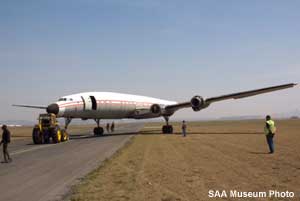 |
CNN Features Qantas Founders Museum Restoration Project – September 10, 2018
Media giant CNN featured an article in the September 3, 2018 edition of their CNN Travel website. Nice to see that occasionally CNN gets a story right
August 2018 California-Arizona Constellation Photos - September 9, 2018
During my August 2018 trip to central California and Arizona I photographed five Constellations that were on display at various museums. Unfortunately there currently are no active aircraft operating in either state but, for the time being, at least these five have been saved from the scrapman.
L049 N90831 – on display at the Pima Air & Space Museum
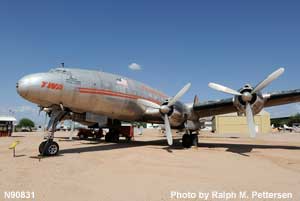 |
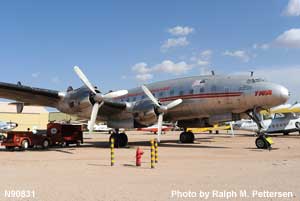 |
 |
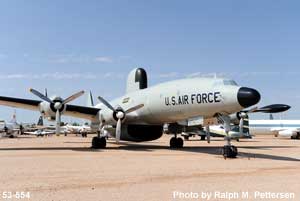 |
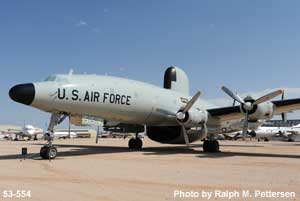 |
 |
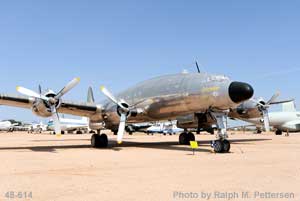 |
 |
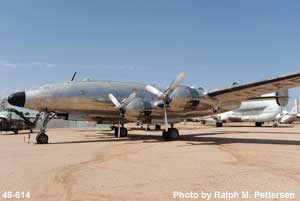 |
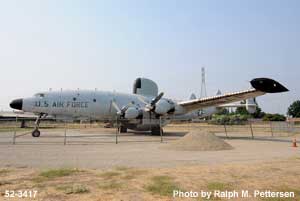 |
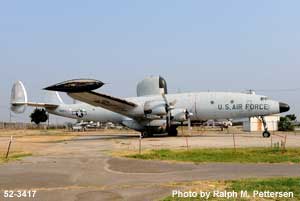 |
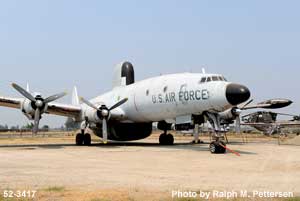 |
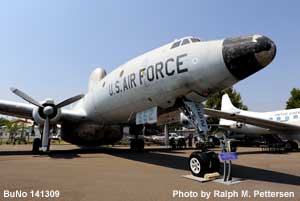 |
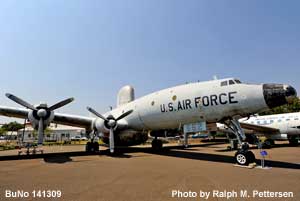 |
 |
During the mid-1990's Arizona had a population of at least eleven Constellations and Super Constellations, with all but three now having been scrapped or moved to other locations for restoration or display. Here's a brief summary of those eight departed aircraft, all of which were former military aircraft.
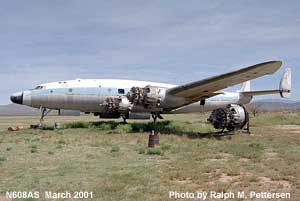 |
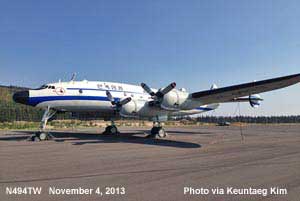 |
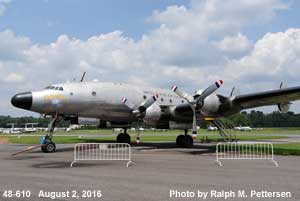 |
 |
 |
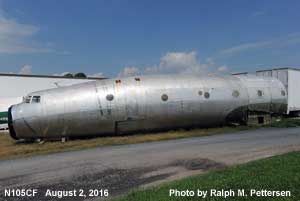 |
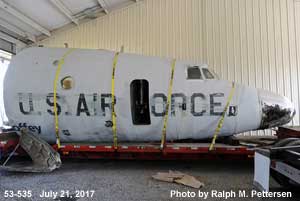 |
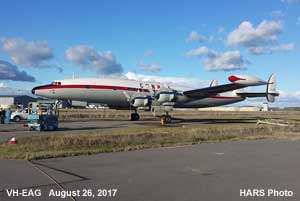 |
New Constellation Book Published – September 6, 2018
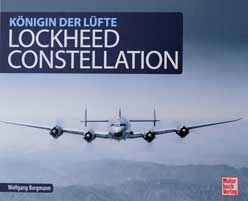 I recently received a copy of Wolfgang Borgmann’s latest book Lockheed Constellation: Königin der Lüfte, which was published in April 2018 by German publisher Motorbuch Verlag. While the 176 page book is written in German, I believe it would be of interest to many of this website’s readers. The hardcover book is profusely illustrated and organized in a logical manner with chapters covering the origins of the design; early development; the various models produced; Lufthansa operations; other major operators; military service; Lufthansa’s Super Star/Starliner restoration project; surviving aircraft; and competing airliner designs. While I cannot read German, this book is a worthwhile and welcome addition my aviation library. It's currently available for about $34/€30 on various regional Amazon sites including amazon.com, amazon.fr, amazon.jp and amazon.de. The book can also be ordered directly from the publisher on their website www.motorbuch.de
I recently received a copy of Wolfgang Borgmann’s latest book Lockheed Constellation: Königin der Lüfte, which was published in April 2018 by German publisher Motorbuch Verlag. While the 176 page book is written in German, I believe it would be of interest to many of this website’s readers. The hardcover book is profusely illustrated and organized in a logical manner with chapters covering the origins of the design; early development; the various models produced; Lufthansa operations; other major operators; military service; Lufthansa’s Super Star/Starliner restoration project; surviving aircraft; and competing airliner designs. While I cannot read German, this book is a worthwhile and welcome addition my aviation library. It's currently available for about $34/€30 on various regional Amazon sites including amazon.com, amazon.fr, amazon.jp and amazon.de. The book can also be ordered directly from the publisher on their website www.motorbuch.de
Restoration of VC-121A Bataan Continues in Chino – September 4, 2018
Ron Vader visited Chino Airport on September 3rd and reports that the restoration of VC-121A 48-613 Bataan Bataan continues at the Fighter Rebuilders facility. The aircraft is owned by Rod Lewis (Lewis Air Legends) and the current plan is to have the restoration completed in a couple of years. VC-121A 48-610 Columbine II is undergoing similar restoration at Dynamic Aviation in Bridgewater, Virginia and the prospect of having two airworthy VC-121A’s is very exciting, to say the least. Many thanks to Ron for sharing his report and photos.
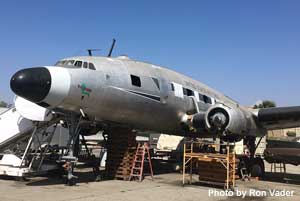 |
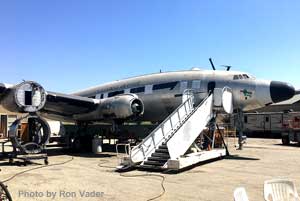 |
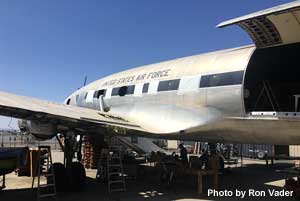 |
South African Airways Museum Marries Starliner Fuselage to Wing Assembly – August 18, 2018
The fuselage and wing assembly of Starliner ZS-DVJ were successfully joined at Rand Airport on August 8, 2018. This marks a significant milestone in the restoration of this aircraft by the South African Airways Museum and hopefully she will be back on her legs in the very near future. For more information and photos about this exciting project, check out the museum’s website.
 |
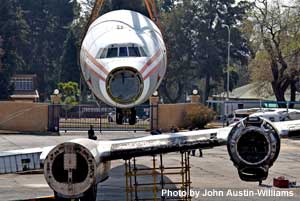 |
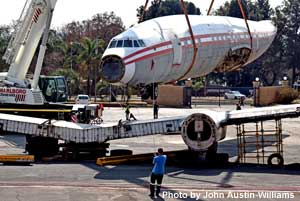 |
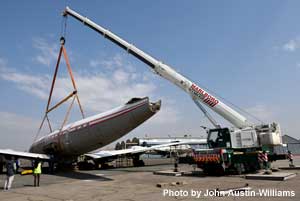 |
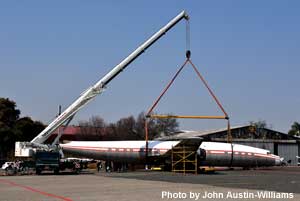 |
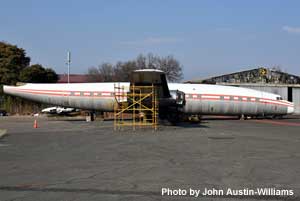 |
Qantas Founders Museum Releases Video – August 7, 2018
The Qantas Founders Museum recently released a short video on Facebook showing the rescue, transport and restoration of their Super Connie. For more information about this exciting restoration, check out the QFM website.
VC-121A Columbine II Restoration Update - July 24, 2018
In light of the recent depressing news regarding Lufthansa's decision to abandon its Starliner restoration project, my July 13, 2018 visit to Dynamic Aviation in Bridgewater, Virginia restored my confidence in the likelihood of another Constellation taking to the air in the not too distant future. Dynamic Aviation founder Karl Stoltzfus is spearheading the effort to restore Dwight D. Eisenhower's first presidential aircraft, Columbine II 48-610. I have been following and writing about this historic aircraft for more than twenty years and, for the past three years, Karl has been gracious enough to allow me to make an annual July pilgrimage to Bridgewater to check on the old girl.
 After signing in with the receptionist, Karl and his assistant Sarah Hedrick greeted me and we headed off to the restoration hangar with a brief stop at a hangar where C-47A Miss Virginia was in the final stages of a facelift in preparation for her upcoming visit to AirVenture 2018. Both the interior and exterior of the aircraft were receiving attention, with original wingtips being installed; a new floor being installed; the cockpit being updated and a new passenger interior being installed. The new interior is being reconfigured to include ten leather coach style seats; five VIP seats; and a four place couch.
After signing in with the receptionist, Karl and his assistant Sarah Hedrick greeted me and we headed off to the restoration hangar with a brief stop at a hangar where C-47A Miss Virginia was in the final stages of a facelift in preparation for her upcoming visit to AirVenture 2018. Both the interior and exterior of the aircraft were receiving attention, with original wingtips being installed; a new floor being installed; the cockpit being updated and a new passenger interior being installed. The new interior is being reconfigured to include ten leather coach style seats; five VIP seats; and a four place couch.
We continued on to Hangar D, where Columbine II is being restored. The airplane shares the hangar with a number of paying customer’s aircraft and its outer wings have been removed to maximize hangar space usage. We were met by Brad Holliday, who is supervising the restoration effort and Karl gave me a 30 minute overview of the project. Karl believes the restoration is about three years from completion, but he emphasized that three years is only an estimate. Although the aircraft had been parked in the desert since 1968 and had almost no corrosion, it was in need of much work to bring it back to its former glory.
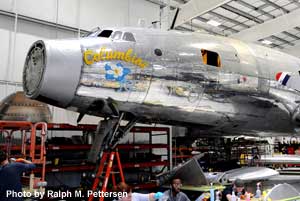 |
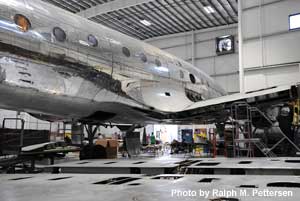 |
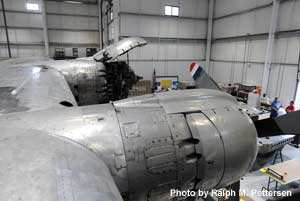 |
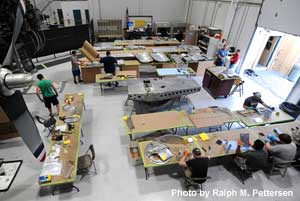 |
 |
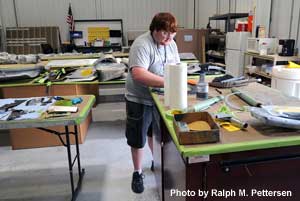 |
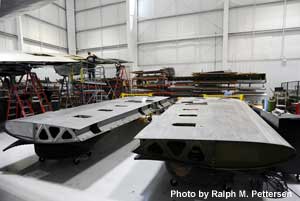 |
 |
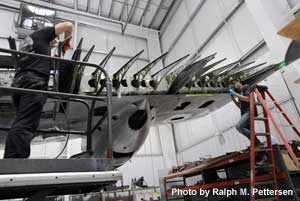 |
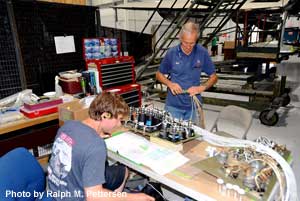 |
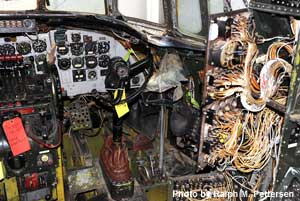 |
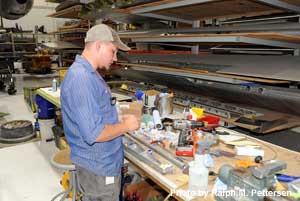 |
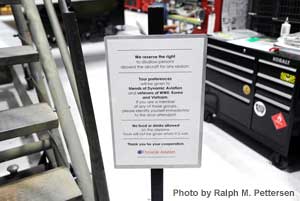 |
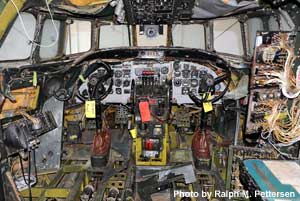 |
 |
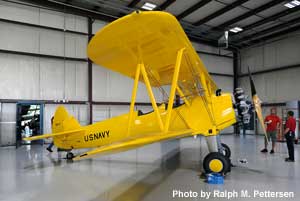 |
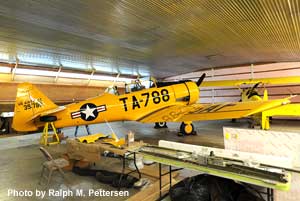 |
 |
South African Airways Museum Starliner Reassembly Update – July 23, 2018
Nine months after arriving at Rand Airport, the two wing sections of Starliner ZS-DVJ were reunited on July 10, 2018. Reassembly of the wing proved to be a formidable and frustrating task for team lead Matt Harvey and his small team of volunteers. Working at best once a week in sometimes harsh conditions, the delicate task involved stabilizing one wing half and gradually moving the other half into position at the correct angle. Acquisition of a second-hand gantry with two 5-ton blocks and tackles in late May gave the team the tool they needed to successfully complete the task. Manny Ceh reports they were ready to mate the wing to the fuselage on July 22nd when the crane was called away for another task. If all goes to plan, the Starliner will be standing on her landing gear in the next month or two! Kudos to Matt and his dedicated band of volunteers for their perseverance and dedication in seeing this project to completion. For additional information about the project, check out the museum’s website.
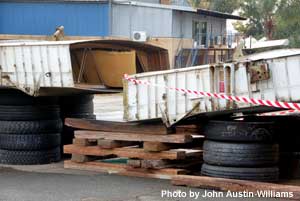 |
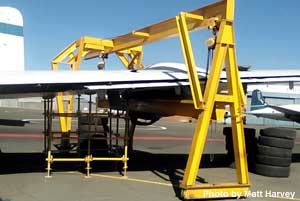 |
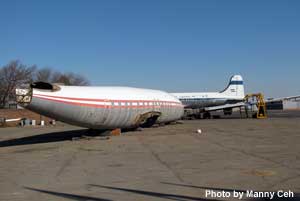 |
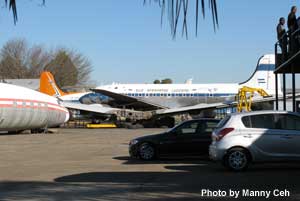 |
 |
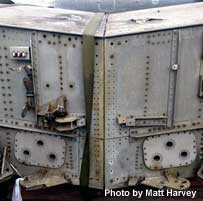 |
November 1952 Photo of Columbine II – July 22, 2018
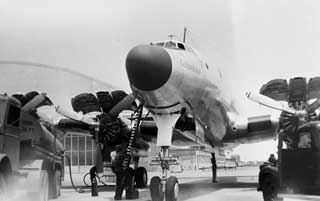 Maria Minster recently forwarded a photo of Columbine II that she said was taken in Korea in late 1952. I checked with Peter J. Marson and sure enough, Columbine II 48-610 was used by President Dwight D. Eisenhower for a Far East trip in November 1952. It’s interesting to note that, while the aircraft name had been applied to the nose, the familiar yellow Columbine flower had not. This is probably the result of the aircraft having only been assigned to the president shortly before the Korean trip was undertaken. After being converted to a VC-121A in late 1949, the aircraft was assigned to the 1254 ATS (Special Missions) at Washington National Airport in February 1950. Prior to Eisenhower’s November trip, the aircraft had been used primarily by the Secretary of the Air Force. Many thanks to Maria for forwarding this very interesting photo.
Maria Minster recently forwarded a photo of Columbine II that she said was taken in Korea in late 1952. I checked with Peter J. Marson and sure enough, Columbine II 48-610 was used by President Dwight D. Eisenhower for a Far East trip in November 1952. It’s interesting to note that, while the aircraft name had been applied to the nose, the familiar yellow Columbine flower had not. This is probably the result of the aircraft having only been assigned to the president shortly before the Korean trip was undertaken. After being converted to a VC-121A in late 1949, the aircraft was assigned to the 1254 ATS (Special Missions) at Washington National Airport in February 1950. Prior to Eisenhower’s November trip, the aircraft had been used primarily by the Secretary of the Air Force. Many thanks to Maria for forwarding this very interesting photo.
Qantas Founders Museum Completes External Restoration of Super Connie – July 21, 2018
The Qantas Founders Museum completed the external restoration of Super Constellation C-121J N4247K in early July. The aircraft was painted to represent L1049H VH-EAM Southern Spray. VH-EAM was the first H model Super Constellation produced and Qantas operated the aircraft for only six years between 1956 to 1962. After being retired by Qantas, VH-EAM was sold in the U.S., where it was registered N7776C. It flew for a number of operators, including Alaska Airlines, before being scrapped in the early 1970’s. I photographed the former Qantas airliner at Fort Lauderdale Airport on Easter Sunday 1972, a few months before it was flown to Columbus, Ohio and scrapped.
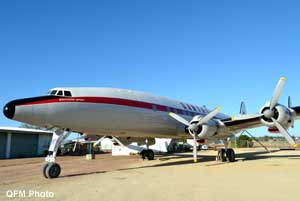 |
 |
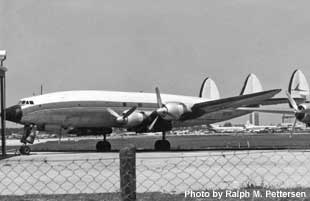 |
Qantas Founders Museum Super Connie Gets Qantas Titles – July 3, 2018
The exterior restoration of Super Constellation C-121J N4247K is nearing completion and on July 1st QFM volunteers added Qantas titles to the aircraft. The airplane looks spectacular and a far cry from what it looked like when it arrived in Longreach a year ago on May 24, 2017. Volunteers can now turn their attention to completing the detail markings and replacing the circular windows with rectangular ones. The aircraft is a former U.S. Navy R7V-1/C-121J aircraft and has circular windows rather than the rectangular windows found on civilian Super Constellations and U.S.A.F. C-121C's. Kudos to the museum for their amazing effort in the restoration of this once near derelict aircraft!
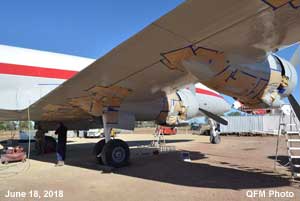 |
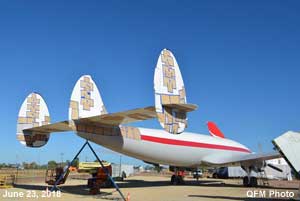 |
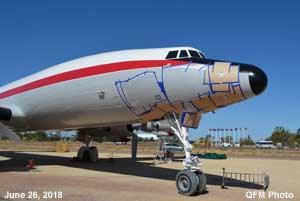 |
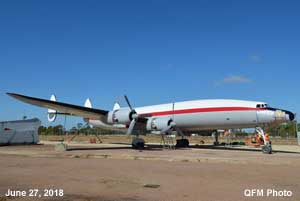 |
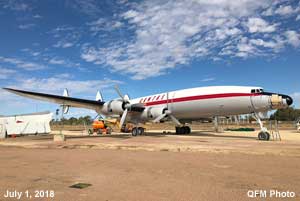 |
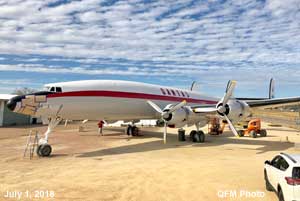 |
Recent Photos of Lufthansa’s Starliner – June 29, 2018
I recently received these photos of Starliner N7316C after the wing had been removed from the fuselage. The wing has obviously been spit in half and, while doing so doesn’t preclude the possibility of the aircraft being restored to an airworthy condition, it makes that task significantly more complicated.
 |
 |
 |
SCFA Super Connie Remains Grounded for 2018 Season – June 26,2018
The Super Constellation Flyers Association recently announced on their website that repairs to their Super Connie HB-RSC would not be completed in time for the Summer 2018 airshow season. While this is no doubt disappointing to the organization and its members, completion of these much needed repairs should allow the aircraft to remain airworthy for many years to come. My hat’s off to the SCFA for their perseverance in their efforts to keep this airplane flying. If only the CEO of Lufthansa had the same spirit and insight, there would have been three flying Constellations in the not too distant future!
Auburn-Lewiston Airport Update - June 25, 2018
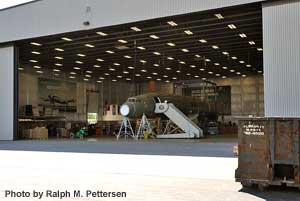 I visited Auburn-Lewiston Airport (LEW) in Maine on June 21st and 22nd to check on the restoration/reassembly of L1649A N8083H and on the ill-fated restoration of Lufthansa’s L1649A N7316C. The Lufthansa Technik (LHT) hangar door was open and I can confirm that the wing has been removed from the fuselage and both were inside the hangar. I spoke to some LHT employees and was told that the fuselage and wing will be stored in the hangar and not outside until they are shipped to Germany some time in 2019. LHT and contractor employees were busy packing a multitude of parts for shipment to Germany and disposing of what is no longer required. Some of the surplus material is being used for the restoration of N8083H. Employees working on the project in Auburn, including senior LHT staff, had no idea that the program was being canceled until they were called into a meeting where the bad news was delivered by LHT managers from Germany. At that time, the front landing gear had been installed; the engine nacelles installed; leading edge plumbing installed; wiring had begun and the main landing gear were scheduled to be installed in the very near future. System testing was expected to begin in the next 12 months with first flight shortly thereafter. The employees I spoke to showed little anger towards Lufthansa but all seemed very disappointed that the project wasn’t taken to completion and had pained looks on their faces while talking about the decision.
I visited Auburn-Lewiston Airport (LEW) in Maine on June 21st and 22nd to check on the restoration/reassembly of L1649A N8083H and on the ill-fated restoration of Lufthansa’s L1649A N7316C. The Lufthansa Technik (LHT) hangar door was open and I can confirm that the wing has been removed from the fuselage and both were inside the hangar. I spoke to some LHT employees and was told that the fuselage and wing will be stored in the hangar and not outside until they are shipped to Germany some time in 2019. LHT and contractor employees were busy packing a multitude of parts for shipment to Germany and disposing of what is no longer required. Some of the surplus material is being used for the restoration of N8083H. Employees working on the project in Auburn, including senior LHT staff, had no idea that the program was being canceled until they were called into a meeting where the bad news was delivered by LHT managers from Germany. At that time, the front landing gear had been installed; the engine nacelles installed; leading edge plumbing installed; wiring had begun and the main landing gear were scheduled to be installed in the very near future. System testing was expected to begin in the next 12 months with first flight shortly thereafter. The employees I spoke to showed little anger towards Lufthansa but all seemed very disappointed that the project wasn’t taken to completion and had pained looks on their faces while talking about the decision.
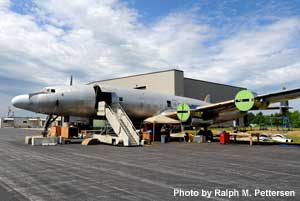 |
 |
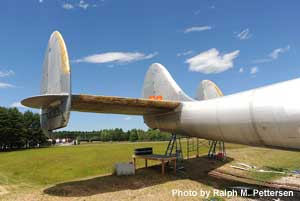 |
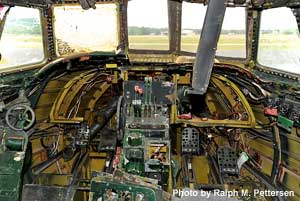 |
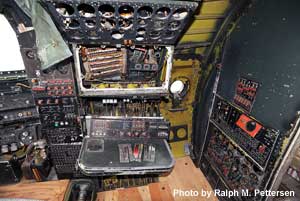 |
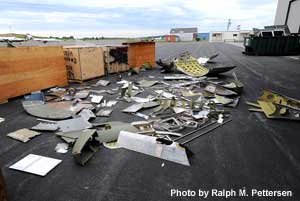 |
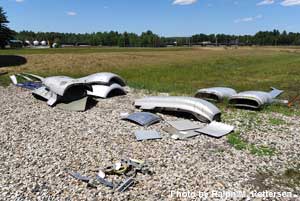 |
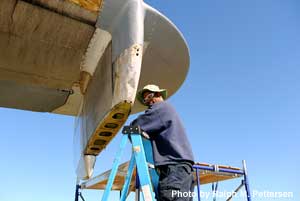 |
 |
Qantas Founders Museum Super Connie Back on Her Legs – June 19,2018
May 25, 2018 was a big day for the Qantas Founders Museum when Super Constellation N4247K was back on her legs again for the first time since being rescued from Manila Airport in 2015. Check out the museum’s website for a comprehensive project overview from inception including 300+ photos. In addition, the website also has a detailed article on recent progress. For those who prefer Facebook, check out the museum's page
 |
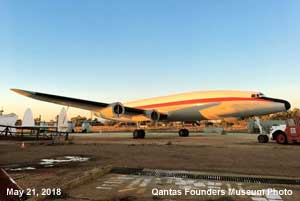 |
 |
Wings Installed on Qantas Founders Museum Super Connie – May 13,2018
Work continues at the Qantas Founders Museum in Longreach on the reassembly and restoration of Super Constellation N4247K. The wings were attached during the week of May 7th and it won’t be too long until the old girl is back on her feet again. Pete from Picton visited the museum on May 13th and forwarded some photos, which I have included with a May 11th museum photo. Kudo’s to the museum for rescuing the aircraft from the scrapman in Manila and making her whole again. Thanks much to Pete for sharing his photos.
 |
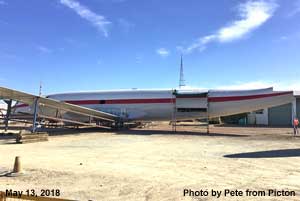 |
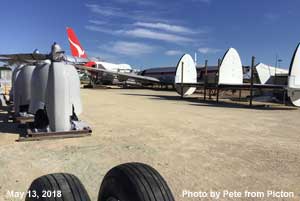 |
Lufthansa Responds to On-line Petition – May 2, 2018
As of today, the Fly-Connie-Fly on-line petition has over 7,600 signatures. Many thanks to all those who have taken the time to sign the petition. Last week Andreas Bartels, Lufthansa’s Head of Communications, sent the following email in response to the petition.
Dear Petition Organizers,
Thank you for your Email and the 7,200 signatures.
Your support and excitement for our Starliner Project is well appreciated. We will for sure not “kill it”.
The aircraft is supposed to be shipped to Germany as the next step of the project will take place at Lufthansa’s home base.
With best regards,
Andreas Bartels
Head of Communications
Lufthansa Group
Mr. Bartels doesn’t specify whether what the “next step” of the project will be. Will the aircraft be reassembled for static display or will it be made airworthy? Also, what “home base” is he referring to…Lufthansa Technik or Lufthansa corporate? I guess only time will tell.
Restoration Continues on Qantas Founders Museum Super Connie – April 27, 2018
As reported on February 19th, work is underway on the restoration of N4247K at the Qantas Founders Museum in Longreach, Australia. The museum released a couple of photos of the aircraft painted in basic Qantas colors. The first was taken on March 20th and the second on April 21st. It appears in April 21st photo that the museum might be close to reattaching the wings.
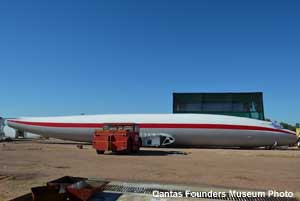 |
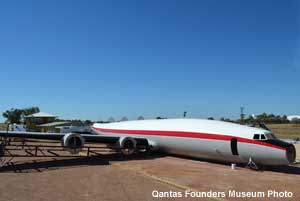 |
”Pirate Airplane” Soldiers on in Santa Cruz, Bolivia – April 27,2018
Sandro Rota recently visited Santa Cruz, Bolivia and photographed veteran Constellation N2520B that locals have named “Avion Pirata” which translates to “Pirate Airplane.” The aircraft was forced to land at Santa Cruz in July 1961, while reportedly on a smuggling flight from Miami to Uruguay with cigarettes and whiskey. It was stored at the airport until the early 1970s when it was moved to a children’s park at Parque Boris Banzer. By 1979 it was in use as a library and later painted in Pepsi colors. The Pepsi colors were removed by 2000, when the aircraft was painted silver with a teal accent stripe and white top. Purchased by AeroSur in early 2003, the aircraft was painted in that airline’s colors. By 2015 it had been painted overall silver. The good news is that the aircraft looks to be in relatively good condition and hasn’t been the target of vandals and graffiti artists. Many thanks to Sandro for sharing his photos.
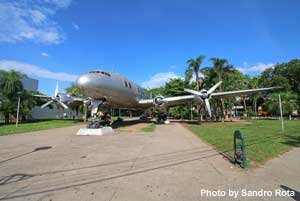 |
 |
 |
Disassembly of Lufthansa Starliner Begins in Auburn – April 16, 2018
I received a report this morning that disassembly of N7316C has begun in Auburn. I guess the April 24th executive board meeting will just be the rubber stamping a decision already made by Lufthansa leadership. The empennage has already been removed as has the wing leading edge. The engine fairings will be next in preparation for the removal of the wing next month. Sad to say but the dream of an airworthy L1649A/Starliner is over. As of today, the Fly-Connie-Fly petition has over 7,000 signatures! Thanks to everyone who signed the petition and sent letters and emails to Lufthansa CEO Carsten Spohr and Supervisory Board Head Karl-Ludwig Kley.
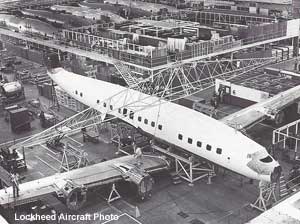 |
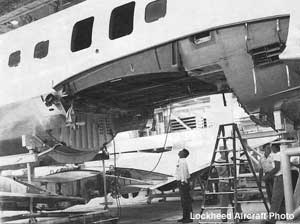 |
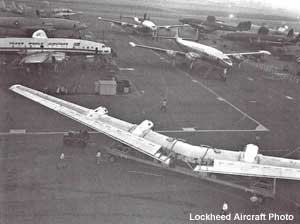 |
Lufthansa Board Meets on April 24th to Decide Fate of Super Star/Starliner Project – April 8, 2018
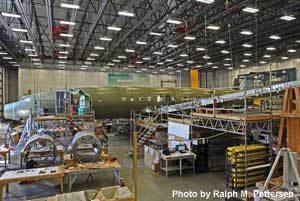 As previously reported on this website in March, Lufthansa executive management has decided to shut down the Super Star restoration project in Auburn, Maine and move the aircraft to Germany. The executive board meets on April 24th to make its final decision on the project. Having come so far with this project, it makes little sense to shut it down so close to completion. As I’ve stated before, I believe that once the wing and fuselage are separated, there is little chance that the aircraft will ever fly again.
As previously reported on this website in March, Lufthansa executive management has decided to shut down the Super Star restoration project in Auburn, Maine and move the aircraft to Germany. The executive board meets on April 24th to make its final decision on the project. Having come so far with this project, it makes little sense to shut it down so close to completion. As I’ve stated before, I believe that once the wing and fuselage are separated, there is little chance that the aircraft will ever fly again.
If you haven’t signed the Fly-Connie-Fly petition, please join the 6,400 who have signed to date. Also email Lufthansa’s CEO Carsten Spohr Carsten.Spohr@dlh.de and the Head of Lufthansa’s Supervisory Board Karl-Ludwig Kley Karl-Ludwig.kley@dlh.de and politely implore them to reconsider the executive board’s decision before it’s too late. If we do something now, we have a chance to change the decision….if we do nothing, the airplane will be disassembled and moved to Germany.
On-line Petition to Lufthansa Executive Management – March 19, 2018
The on-line petition Fly-Connie-Fly has been created in an effort to reverse the recent decision by Lufthansa CEO Carsten Spohr and Chairman of Lufthansa’s Supervisory Board Karl-Ludwig Kley to shut down the Super Star restoration project in Auburn, Maine. As reported in the Auburn-Lewiston Sun Journal on March 15th, the company plans on removing the 150 foot wing and shipping the aircraft to Germany for completion of the restoration.
Separating the wing from the fuselage and shipping the project to Germany will most likely result in the aircraft never flying again. Dismantling and moving the project would also entail costs that could be better used to complete the restoration in Auburn.
Aviation enthusiasts all over the world! Please sign the Fly-Connie-Fly petition to Lufthansa management letting them know you want Lufthansa to complete this project in Auburn and make this unique flying monument available for the public to enjoy. Thanks for your help.
Lufthansa Starliner Restoration Update and Call to Action – March 18, 2018
On the morning of March 15th I reported on this website that Lufthansa was shutting down its L1649A Super Star restoration project at Auburn-Lewiston Airport in Maine. I also posted the report on a number of aviation related Facebook pages.
Later that day Lufthansa Technik announced in an article published in the Auburn-Lewiston Sun Journal newspaper that they would be “removing the wings from the historic aircraft and taking it to Germany later this year to finish the decade-long restoration.” Auburn based Lufthansa Technik project manager Oliver Sturm was quoted in the article as saying “The airplane is too complex to finish here because it’s a very old aircraft, coming from the ’50.” (Wow...did he really say that...the project is complex to be completed in the United States?)
For a number of reasons I believe that, if the aircraft is disassembled and moved to Germany, it will never fly again. This belief is based on recent confidential communications I've had with individuals involved in the project and the considerable challenge of moving the aircraft from the United States to Germany without damaging it. The wing is a 150 foot long one-piece structure that is an integral part of the fuselage structure. Once the wing has been separated from the fuselage, the fuselage will have to be supported for the long land/sea voyage to Germany. I don't believe this has ever been done before and the possibility of damaging the fuselage during the de-mating process and enroute to Germany should be a major concern.
If the airplane goes to Germany, I believe that the best case scenario would have the aircraft becoming the world’s most expensive static display airplane. The worst case scenario would have it disassembled and stored in warehouse, or even worse, stored outside and exposed to the weather.
It is imperative that we make every attempt to change Lufthansa’s decision to shut down the Maine based restoration and move the aircraft to Germany. Email Lufthansa’s CEO Carsten Spohr Carsten.Spohr@dlh.de and the Head of Lufthansa’s Supervisory Board Karl-Ludwig Kley Karl-Ludwig.kley@dlh.de and politely implore them to reconsider the executive board’s decision before it’s too late.
An on-line petition is in the works and I will publish a link to it when I receive it.
Peter Brill Reports from Rand on Latest Status on Starliner ZS-DVJ – March 18, 2018
Peter Brill recently visited Rand Airport and reports on the latest status of the restoration of Starliner ZS-DVJ......."Here are the latest photos of the SAA Starliner ZS-DVJ reassembly at Rand, South Africa. I met the project manager Matt Harvey as guest of the SAA Museum who went out of his way to show me around. The main issue in the moment is to line up the wings which had to be split for transport. On the Starliner there are no inner or outer wing panels like on the earlier Connie models. So there was no other option than to unbolt the two wing halves. Once these are joined up again the fuselage will follow and the aim is to have the Starliner on its feet as soon as possible as it is occupying valuable space at Rand in the moment. Thanks Matt for your hospitality."......Many thanks to Peter for sharing his report and photos.
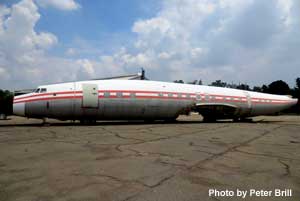 |
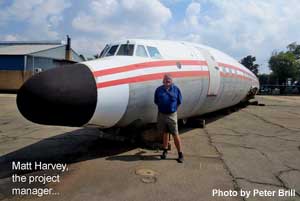 |
 |
 |
 |
 |
Lufthansa Shuts Down Super Star Project – March 15, 2018
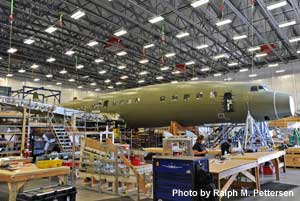 I was informed this morning by a number of sources that the Lufthansa Board of Directors has decided to pull the plug on the Super Star (L1649A) project in Auburn, Maine. The restoration was begun in 2008 and, after spending a reported $200M on the project, the board has made the misguided decision to end the project, which was nearing completion. I’ve made a number of visits to Auburn over the past ten years and the aircraft (N7316C) was being restored to the highest standards and would have provided Lufthansa with a great tool for promoting the airline. It’s a bit perplexing to me to why, after spending so much money on the project, the board would shut it down when it was so close to completion. It’s obvious that the board is more worried about the airline’s bottom line than preserving its legacy. Perhaps if we create a large enough “shitstorm” about the decision, the board might be convinced to reverse it.
I was informed this morning by a number of sources that the Lufthansa Board of Directors has decided to pull the plug on the Super Star (L1649A) project in Auburn, Maine. The restoration was begun in 2008 and, after spending a reported $200M on the project, the board has made the misguided decision to end the project, which was nearing completion. I’ve made a number of visits to Auburn over the past ten years and the aircraft (N7316C) was being restored to the highest standards and would have provided Lufthansa with a great tool for promoting the airline. It’s a bit perplexing to me to why, after spending so much money on the project, the board would shut it down when it was so close to completion. It’s obvious that the board is more worried about the airline’s bottom line than preserving its legacy. Perhaps if we create a large enough “shitstorm” about the decision, the board might be convinced to reverse it.
Super Connie Restoration Underway at Qantas Founders Museum – February 19, 2018
Since arriving at the museum on May 24, 2017, volunteers and staff have wasted no time in moving forward with the restoration of C-121J N4247K. The aircraft had been parked in the weeds at Manila International Airport since 1988 and was in desperate need of attention when the museum acquired it at auction in September 2014. On February 13th a makeshift paint booth was lowered over the fuselage and by the 19th it had been sandblasted and painted. It’s great news that this long neglected aircraft is finally receiving the TLC it deserves and I will provide future project updates as I receive them.
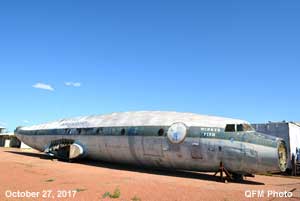 |
 |
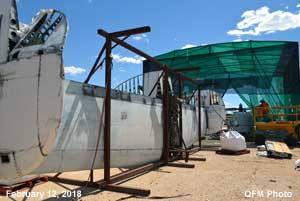 |
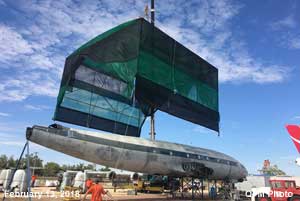 |
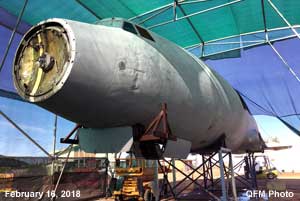 |
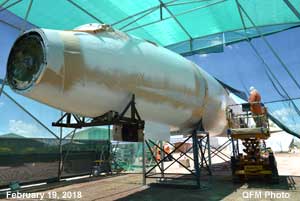 |
Turkish Navy Discovers Air France Constellation – February 17, 2018
The Turkish Navy recently located Air France L749A Constellation F-BAZS 1½ miles off the coast of Turkey in 842 feet of water. The aircraft made a successful emergency night landing in the Mediterranean on August 3, 1953 after the #3 engine separated from the aircraft while on a flight from Paris to Tehran. With 34 passengers and a crew of 8, the airplane stayed afloat for an hour allowing the rescue of all but 4 elderly passengers, who drowned. The aircraft was delivered to Air France in 1950 and is remarkable intact after being submerged for almost 65 years.
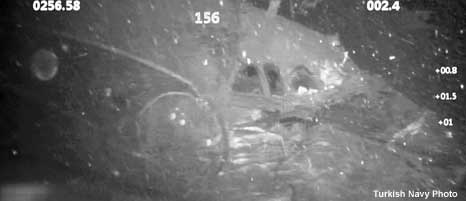 |
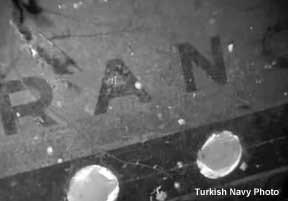 |
LSSG Publishes Super Star Chronicle – Issue #1 – February 16, 2018
In mid-December 2017 Lufthansa Super Star gGmbH (LSSG) published Super Star Chronicle Issue #1, which provides a very nice overview of progress on the restoration of L1649A N7316C. Included are an overview of 2017 accomplishments; challenges faced by the team in overhauling the myriad of components needed to complete the restoration; the incorporation of modern escape slides; and the role of reverse engineering in the project.
 |
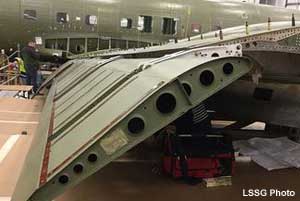 |
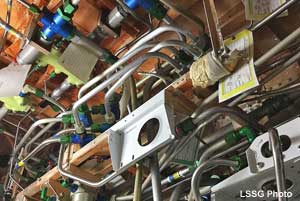 |
Former TWA Starliner to be Centerpiece of JFK Airport Hotel – January 28, 2018
On March 13, 2017 I reported that L1649A N8083H was the most likely candidate to become the centerpiece of a 500 room hotel being constructed adjacent to the old TWA terminal at JFK Airport. I recently confirmed that the aircraft will indeed be used for the project and ownership is scheduled to be transferred on March 1, 2018. The aircraft will be set up as a high end cocktail lounge seating about 40 guests with the interior fitted out to replicate a 1950’s era airliner. No fuselage cuts will be required as the aircraft passenger doors will be used to access the cocktail lounge. The cockpit has been stripped of many parts and components but, since N7316C will have a glass cockpit, most of the parts to restore the cockpit should be available. The current plan is to have the fully restored cockpit on display for cocktail lounge customers.
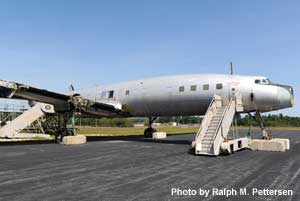 |
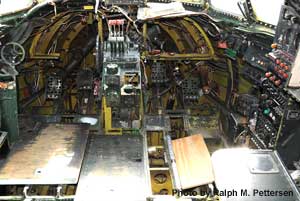 |
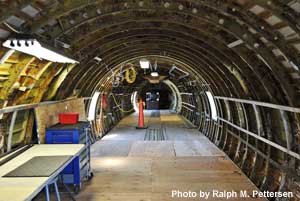 |
It sounds like a very exciting project and I wish the restoration crew luck in this very ambitious endeavor. I will be posting updates as the project progresses.
| Page Top | Home |
----Created 31 January 2004------Updated 26 January 2019----